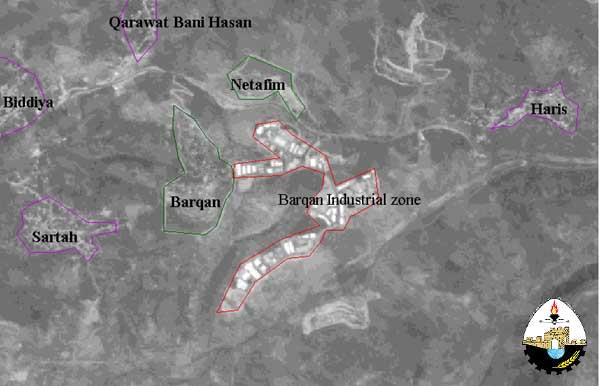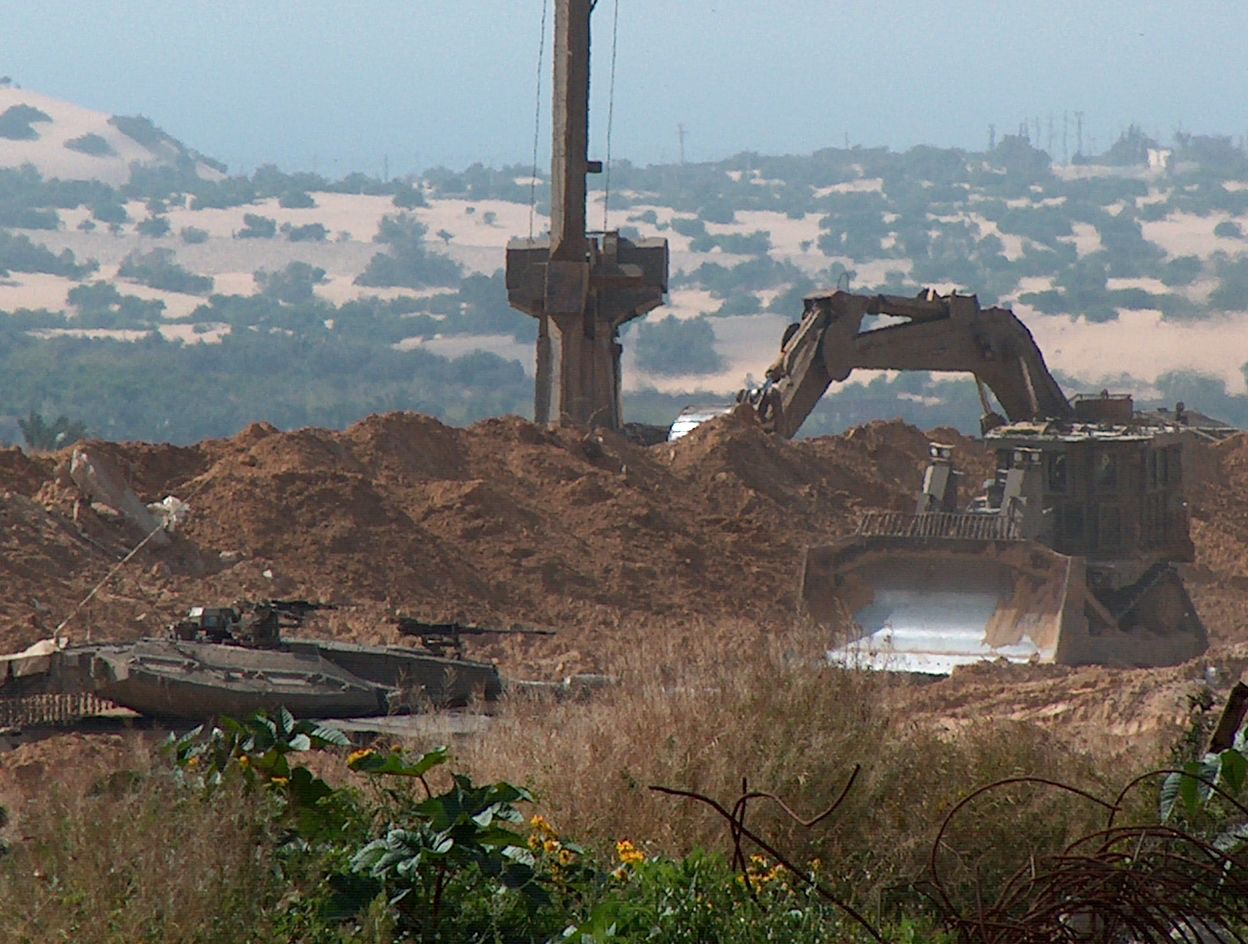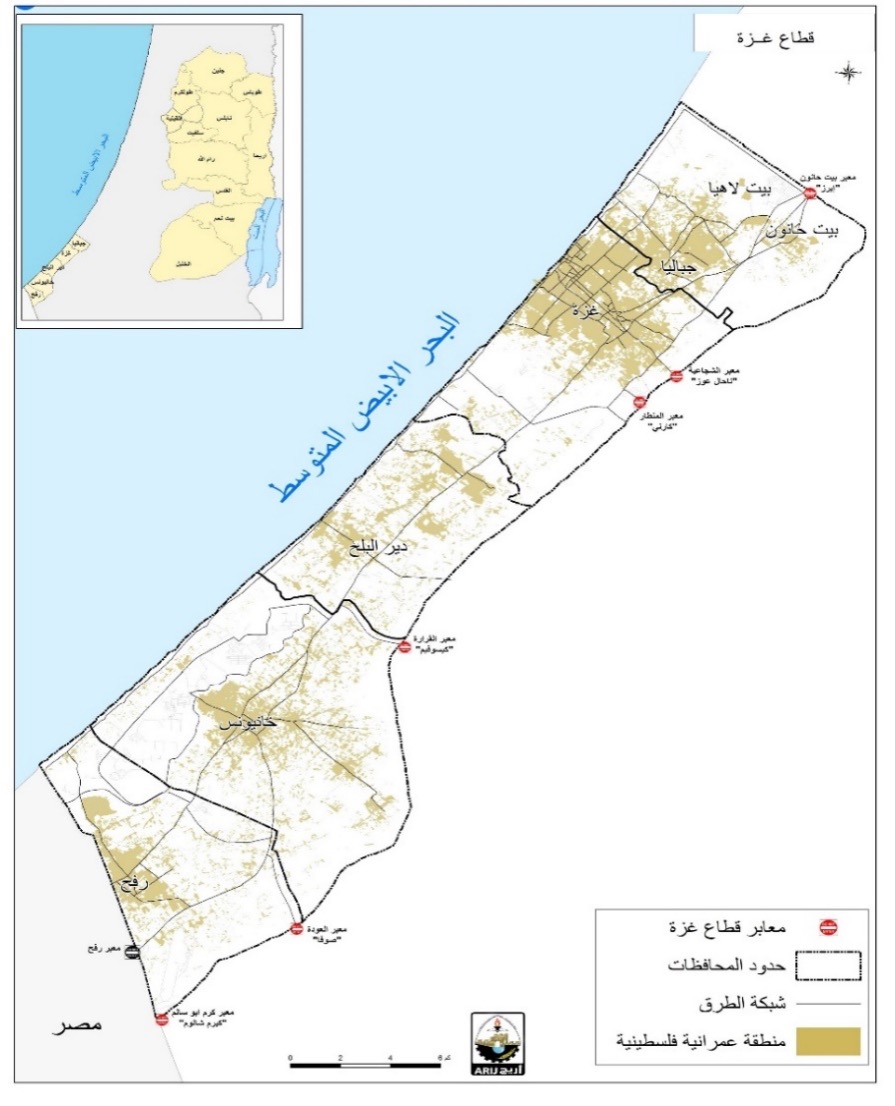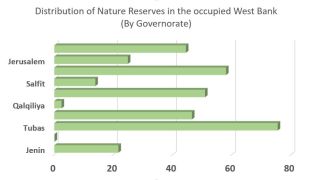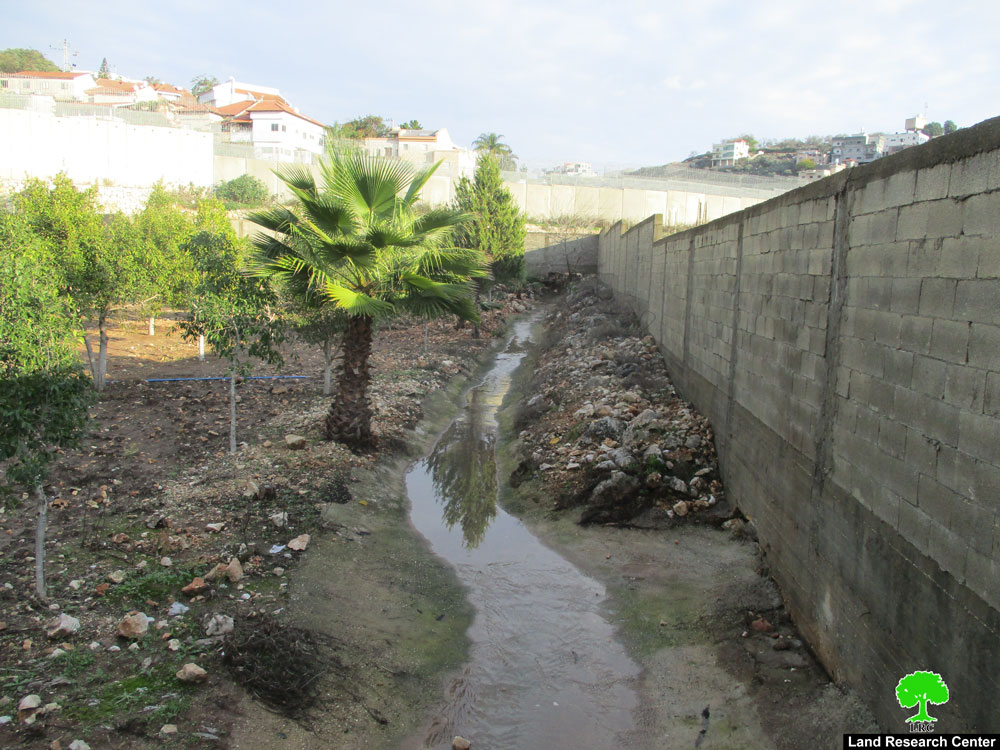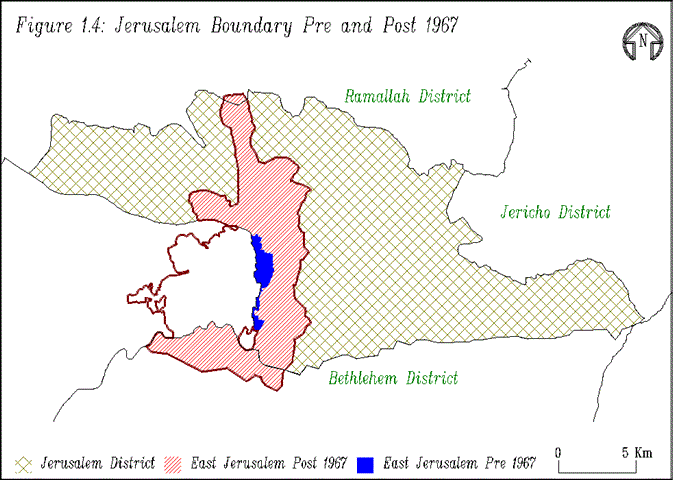Introduction:
Industrial pollution is considered one of the major issues in environmental protection. Industries contribute to the pollution of the environment, especially in the absence of regulations that force manufacturers to reduce their hazardous impact. Nevertheless, Jewish colonies in the West Bank host several polluting industries which produce hazardous waste. These industries include aluminum, batteries, leather tanning, textile dyeing, fiberglass and other chemical industries. Waste generated from these industries affects various areas in the West Bank. While information is scarce, it is crucial to focus on polluting industries inside the Jewish industrial zones and their impact on the West Bank environment. Barqan industrial zone will be taken as a case study, where industrial waste flows to the nearby valley.
Industrial Zones in Colonies
There are at least seven industrial zones in the colonies in the West Bank. Figure 1shows the location of the Jewish industrial zones in the West Bank. These industrial zones occupy an area of approximately 302 hectares.shows the location of the Jewish industrial zones in the West Bank. These industrial zones occupy an area of approximately 302 hectares.

Figure 1Location of the Jewish industrial zones in the West Bank.
A’tarot, Mishor Adumim, and Barqan industrial zones are the largest in the West Bank. They are mainly located on tops of hills, which often results in the flow of industrial wastewater into adjacent Palestinian lands. Recently, Israel has given permits to four new Jewish industrial zones to be established in the West Bank. These industrial zones are to be located in Area C near Ramallah, Nablus, Hebron and the Jordan Valley. Table 1 lists the Jewish industrial zones in the West Bank and the area each one of them occupies. Table 1
|
Industrial zones in colonies in the West Bank |
||
|
Industrial Zone |
District |
Area (hectare) |
|
Hinnanit |
Jenin |
10.99 |
|
Barqan |
Nablus |
14.87 |
|
Ariel |
Nablus |
14.84 |
|
Ma’ale Efrayim |
Nablus |
2.58 |
|
‘Atarot |
Jerusalem |
145.78 |
|
Mishor Adummim |
Jerusalem |
109.92 |
|
Qiryat Arba’ |
Hebron |
3.35 |
|
Total |
|
302.00 |
It is estimated that at least 200 Jewish industrial factories are located within the West Bank. These factories are either located in the Jewish industrial zones or inside Jewish colonies. Information about Jewish industrial activities in the West Bank is scarce. Some of their products are identified, but detailed information on quantities produced, labors and waste generated is not available. The major industries within these industrial zones include: Aluminum, leather tanning, textile dyeing, batteries, fiberglass, plastics, and other chemical industries. Table 2 lists the Jewish industries in the West Bank. Table 2
|
Jewish Industries in the West Bank |
||
|
District |
Industrial Location |
Industry |
|
Nablus |
Barqan |
Aluminum, fiberglass |
|
|
|
plastic, electroplating |
|
|
Allon Morieh |
Aluminum, food canning and textile dyeing |
|
|
Shilo |
Aluminum and leather tanning |
|
Ramallah |
Halmeesh |
Fiberglass and leather tanning |
|
|
Givout hadasha |
Rubber |
|
|
Nili |
Aluminum |
|
|
Shelta |
Fiberglass and plastic |
|
|
‘Atarot |
Aluminum, cement, plastic, food canning and others |
|
Hebron |
Qiryat Arba’ |
Winery, building blocks, tiles and plastic |
|
Jerusalem |
Mishor Adummim |
Plastic, cement, leather tanning, detergents, textile dyeing, aluminum, electroplating and several others |
|
Jenin |
Homesh |
Batteries, aluminum, detergents |
|
Tulkarm |
Near 1967 border, inside the West Bank |
Pesticide, fiberglass and Dixon gas |
Israel has moved many of its polluting industries from places inside Israel to areas near the 1967 border or inside colonies. For example, a pesticide factory in Kfar Saba which produces dangerous pollutants has been moved to an area near Tulkarm, inside the West Bank. The wastewater from these factories has damaged the citrus trees and polluted the soil in the area, in addition to the damage that it may cause to the groundwater.
As a further example, the Dixon gas industrial factory which was located in Netanya has been moved into the same area near Tulkarm. Solid waste from these industries is burned in free air. In February 1997, the Palestinian Ministry of Health tested the solid waste located in the western section of Tulkarm city and reported that fiberglass and polyesters were present. The burn of this waste results in the emission of dangerous black smoke and toxic gases. Moreover, the western winds move these fumes into residential and public areas in Tulkarm city and the neighboring villages, causing a health risk.
It is reported that the Jewish government has moved a Jewish military camp from this area because Jewish soldiers have been affected by the fumes of these industries. Recently, 200 dunums of land were prepared in Mishor Adummim industrial zone for the purpose of moving aluminum and copper factories from the area of Giva'at Shaul in west Jerusalem. Also, an iron melting factory was built near Al-Nabi Elias Village on the main road from Qalqilya to Nablus.
Industrial Wastes and their Environmental Impacts
Most of the Jewish industries in the West Bank produce hazardous liquid and solid wastes. Hazardous wastes can be defined as wastes that pose a potential hazard to humans, plants or animals. These wastes can be in the form of sludge, liquid, gas or solid. The impact of industrial discharge depends not only on its collective characteristics such as biological oxygen demand (BOD) and suspended solids, but also on its content of specific inorganic substances.
Generally, the accurate composition of industrial waste cannot be easily determined unless laboratory analysis is conducted, as its quality depends on the type of manufacturing process involved. Palestinian scientists face difficulties in collecting waste samples due to lack of access to the effluent source. Therefore, only estimates of the generated waste composition can be made, where the type of industry indicates the major constituents of the hazardous material in the waste. The generated industrial wastes contain toxic elements such as aluminum, chromium, lead, zinc and nickel. For example aluminum industry produces aluminum and acidic wastes. Electroplating produces nickel, chrome and acidic wastes. All of these inorganic substances are considered hazardous and negatively affect the health if accumulated in the body.
Palestinian lands located at the foothills of industrial zones are highly vulnerable to the flow of industrial waste. Evidence shows that pollution prevention measures are not followed inside the Jewish industrial facilities. Also, the generated industrial solid waste is often collected and dumped at areas near Palestinian villages. Table 3 shows some Palestinian villages affected by industries in some of the Jewish industrial zones. Table 3
|
Palestinian locations affected by Jewish industry in the West Bank |
|
|
Jewish industrial location |
Affected Palestinian location |
|
Halmeesh |
Al-Nabi Saleh village |
|
Mishor Adummim |
Jerusalem Desert |
|
Homesh |
Silat Al-Thahir |
|
Barqan |
Kafr Al-Deik, Sarta, and Bruqin villages |
|
Shilo |
Qaryout and Turmus ‘Ayya |
|
Allon Moreh |
Nablus- Wadi Badan road |
|
‘Atarot |
Bir Nabala and Judeira |
|
Qiryat Arba’ |
Bani Na’im |
|
Jewish Industrial zone on 1967 border near Tulkarm |
Tulkarm city, nearby agricultural areas |
The Barqan Industrial Zone:
The Barqan industrial zone is located in the Nablus district and occupies an area of 150 dunums.

Figure 2. Location of the Barqan industrial zone.
It hosts approximately 80 industrial factories of different industries such as aluminum, fiberglass, plastic, electroplating and military industries. There are three aluminum factories, and several plastic factories. These industries produce large quantities of hazardous liquid and solid wastes. Industrial wastewater generated from Barqan industrial zone flows into the nearby wadi and pollutes the agricultural lands which belong to three Palestinian villages; Sarta, Kafr ed Deik and Bruqin, in the Nablus district. It is estimated that this industrial zone generates approximately 810 thousand cubic meters of industrial wastewater annually. In 1991 and 1992, the Jewish Regional Council (Shomron) conducted a study to evaluate the composition of the generated waste. The study showed that the generated waste was not meeting standards and contatoxic and hazardous chemicals. The director of the industrial zone was informed about the results, but did not stop this disaster. The wastewater had been previously collected in three storage tanks. Due to a design failure, these tanks are currently overloaded with mud and not in operation. Therefore, the industrial wastewater flows untreated to the nearby wadi.
Figure 3 is an aerial photo taken in May 1995.
The figure shows clearly two wastewater streams generated from the Barqan industrial zone. The first is flowing to Wadi Rabahand damages the agricultural land of the nearby villages. The other flows towards Wadi Qana. It has been observed that the wastewater continues to flow as shown in the Landsat Satellite Image taken in 1996.
Landsat Satellite Image taken in 1996, Figure 4.
As stated in the Al-Quds Newspaper no 9915 of April 2nd, 1997, hundreds of cows and sheep drink from the Barqan industrial zone wastewater stream and eat the polluted nearby plants. Their dairy products are marketed in the cities of Nablus and Salfeet. People living near the northern entrance of Bruqin village are also vulnerable to the wastewater stream which flow through this area.
In sum, Israel is polluting the West Bank environment through the large number of Jewish industries located in the West Bank. The Israeli law for the protection of the environment is not applied to the Jewish industries in the West Bank. The generated wastewater from most of these industries is not treated and as a consequence, heavy metals often flows into Palestinian fields. Moreover, the generated solid waste is generally dumped without treatment into Palestinian land. These practices will undoubtedly pollute the groundwater in the West Bank as toxic waste has the potential to seep into groundwater. Strict measures have to be followed in the disposal of liquid and solid waste in order to ensure the protection of the groundwater.
Land confiscation to construct new Jewish industrial zones in the West Bank that serve the Jewish needs is rejected by Palestinians. The confiscation policy has to be stopped and the existing Jewish industries have to be moved to areas inside Israel. Environmental awareness programs on the effect of hazardous materials in water on health have to be initiated. Also, Palestinians scientists and officials have to inform International environmental, heath and human rights organizations about the effect of the Jewish industries on the Palestinian environment and health.
Prepared by:
The Applied Research Institute – Jerusalem


